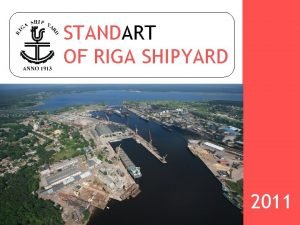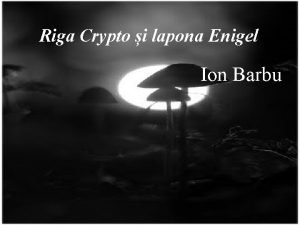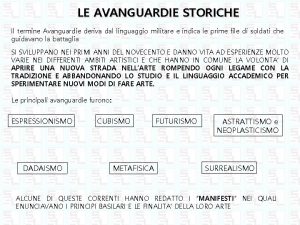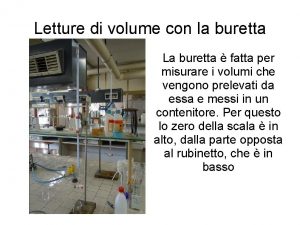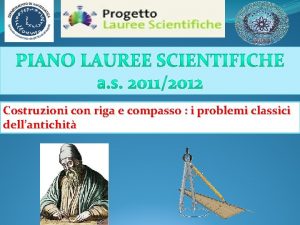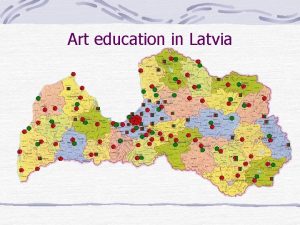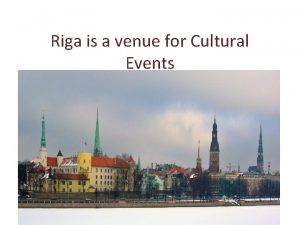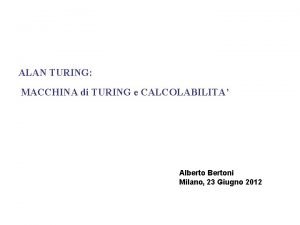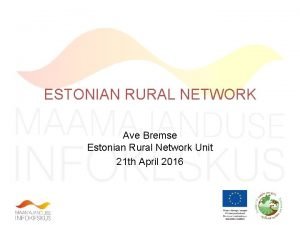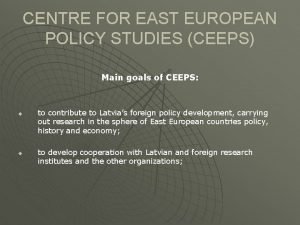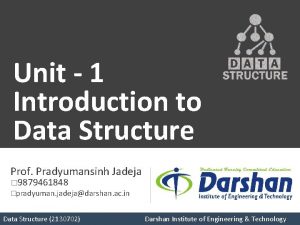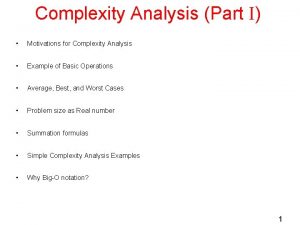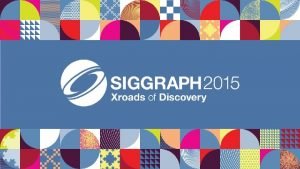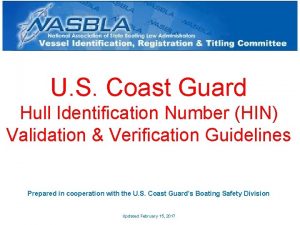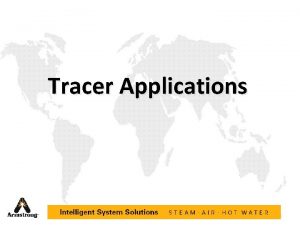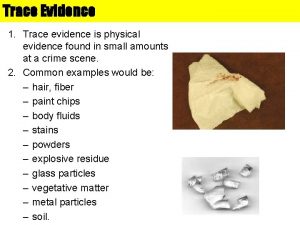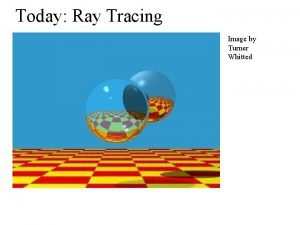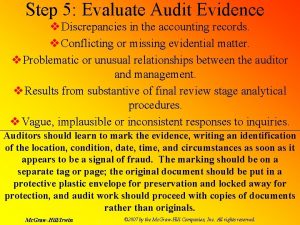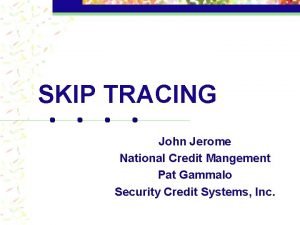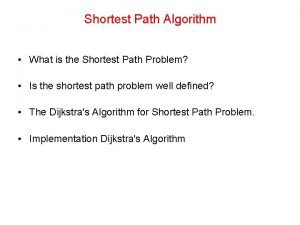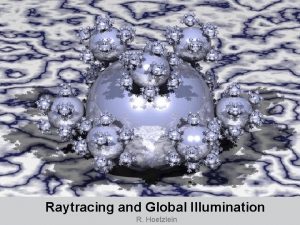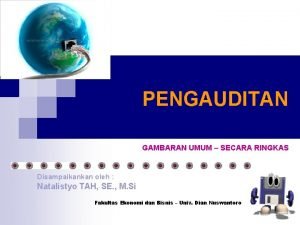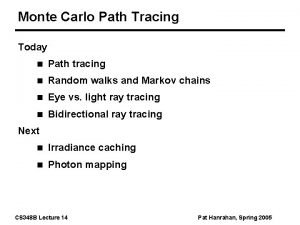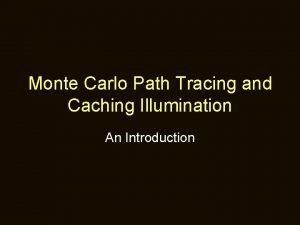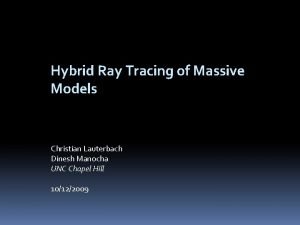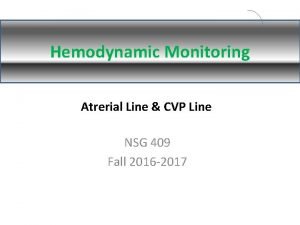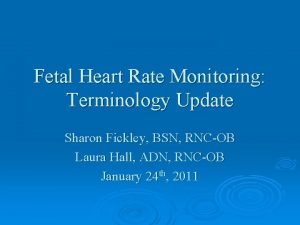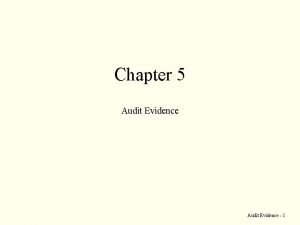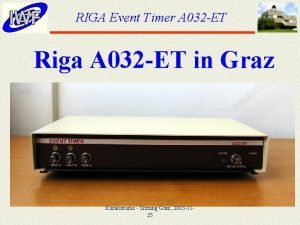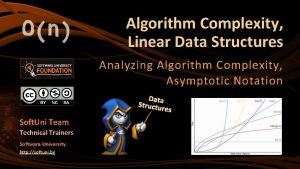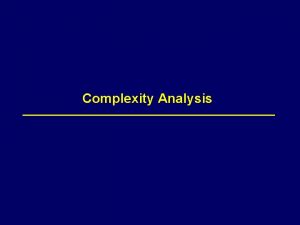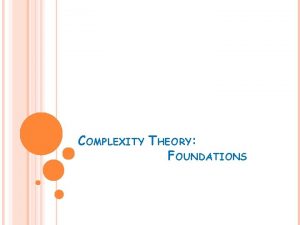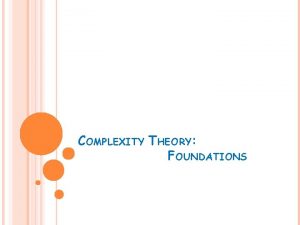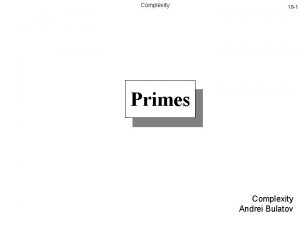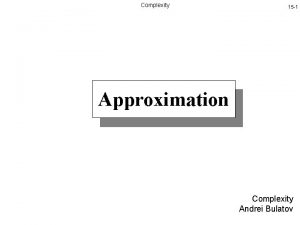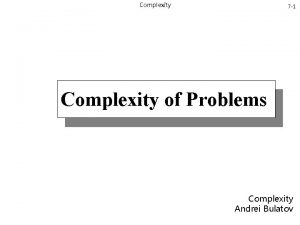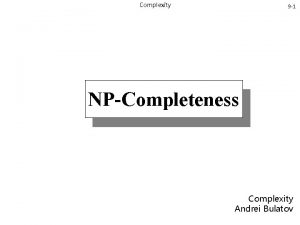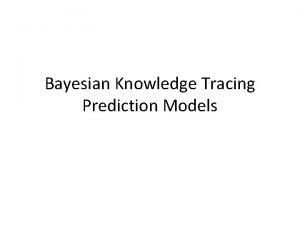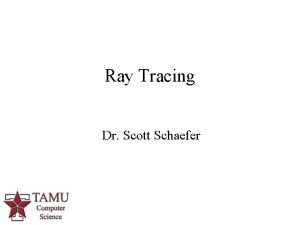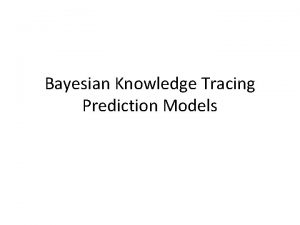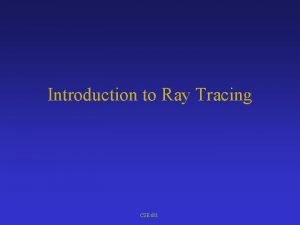Complexity of tracing Data Structures FCLCourse Riga 15










































- Slides: 42

Complexity of tracing: Data Structures FCL-Course, Riga, 15 th March 2016

Complexity of tracing: Data Structures CONTENTS n n n What is traceability? 1 st step: Processing 2 nd step: Transport 3 rd step: Information flow A simple data model Let’s jump into the reality Olaf Mosbach-Schulz Riga, 15 th March 2016, 2

Complexity of tracing: Data Structures GENERAL FOOD LAW / EC REGULATION 178/2002 Article 3(15): Traceability means the ability to trace and follow a food, feed, food-producing animal or substance intended to be, or expected to be incorporated into a food or feed, through all stages of production, processing and distribution. Olaf Mosbach-Schulz Riga, 15 th March 2016, 3

Complexity of tracing: Data Structures GENERAL FOOD LAW / EC REGULATION 178/2002 Article 18: 1 -step back/ 1 -step forward traceability 1. The traceability of food, feed, food-producing animals, and any other substance intended to be, or expected to be, incorporated into a food or feed shall be established at all stages of production, processing and distribution. “Traceability of food should be established at all stages of production, processing and distribution” 2. Food and feed business operators shall be able to identify any person from whom they have been supplied with a food, a feed, a foodproducing animal, or any substance intended to be, or expected to be, incorporated into a food or feed. To this end, such operators shall have in place systems and procedures which allow for this information to be made available to the competent authorities on demand. “Food business operators shall be able to identify any supplier” 3. Food and feed business operators shall have in place systems and procedures to identify the other businesses to which their products have been supplied. This information shall be made available to the competent authorities on demand. “Food business operators shall be able to identify any client” 4. Food or feed which is placed on the market or is likely to be placed on the market in the Community shall be adequately labelled or identified to facilitate its traceability, through relevant documentation or information in accordance with the relevant requirements of more specific provisions. “Food shall be adequately labelled or identified to facilitate its traceability” 5. Provisions for the purpose of applying the requirements of this Article in respect of specific sectors may be adopted in accordance with the procedure laid down in Article 58(2). Olaf Mosbach-Schulz Riga, 15 th March 2016, 4

Complexity of tracing: Data Structures A FOOD CHAIN WITH ITS STAGES / ACTORS Primary producer Handling of by-products/waste (feed / fertilizer) Loops Broker (Consolidator) Processor Wholesaler Distributor Short - cuts Retailer Cash & Carry Caterer Olaf Mosbach-Schulz Consumer Riga, 15 th March 2016, 5

Complexity of tracing: Data Structures SEVERAL DEFINITIONS OF TRACEABILITY But one important distinction 1: “Tracking is the informative process by which a product is followed along the supply chain keeping records at each stage, (…). ” (Prospective data collection) “Tracing is defined as the ability of reconstructing the history of a product, identifying its origin (…). ” (Retrospective data collection) Forward Tracing Backward Tracing 1 Recall Tracking Tracing Retrospective Prospective Pizzuti & Mirabelli (2015): The global track&trace system for food Olaf Mosbach-Schulz Riga, 15 th March 2016, 6

Complexity of tracing: Data Structures SEVERAL DEFINITIONS OF TRACEABILITY n n n Product traceability is the reconstruction of the physical product flow, the location of a product at any stage of the food supply chain. Process traceability is the reconstruction of all transformations of the product, including interactions with physical/mechanical, chemical, and environmental factors. Genetic traceability is the reconstruction of the genetic constitution of ingredients of the product. This is used to identify ingredients, their origin, or if they are genetically modified. Inputs traceability is the reconstruction of types, source and supplier of all ingredients used during production and processing. Disease and pest traceability reconstructs the epidemiology of pests and biotic hazards that may contaminate food or feed. Measurement traceability is the reconstruction of data and quality of measurements. Reference: Opara (2003) Olaf Mosbach-Schulz Riga, 15 th March 2016, 7

Complexity of tracing: Data Structures SEVERAL DEFINITIONS OF TRACEABILITY There exist no common definition of traceability, but several approaches 1 Working definition of (product) traceability Traceability is defined as the ability to retrospectively follow the movement of food, feed, food-producing animal or substance intended to be, or expected to be incorporated into or in contact with food or feed, through all stages of production, processing and distribution by means of recorded data. 1 Olsen & Borit (2012): How to define traceability Olaf Mosbach-Schulz Riga, 15 th March 2016, 8

Complexity of tracing: Data Structures Which data do we need to reconstruct the history of a food item (suspected to be the cause of a disease) ? Olaf Mosbach-Schulz Riga, 15 th March 2016, 9

Complexity of tracing: Data Structures MICRO STRUCTURE Actor 1 Storage In Processing Storage Out Transportation Delivery Transportation Taking Delivery Actor 2 Storage In Olaf Mosbach-Schulz Processing Storage Out Riga, 15 th March 2016, 10

Complexity of tracing: Data Structures 1 st step: Processing Olaf Mosbach-Schulz Riga, 15 th March 2016, 11

Complexity of tracing: Data Structures GRANULARITY OF PROCESSING Actor Storage 1 Pre-processing Ingredient A: Pre-processing Post-processing Lot #In. A 1 Lot #In. A 2 Storage 3 Ingredient B: Service Product: Food Product: Lot #In. B 1 Lot #In. S 1 Lot #Out. F 1 Lot #In. B 2 Lot #In. S 2 Lot #Out. F 2 Olaf Mosbach-Schulz Storage Out Riga, 15 th March 2016, 12

Complexity of tracing: Data Structures TRACING UNIT FOR PROCESSING Actor : Production of Lot # Out. F 1 Storage 1 Processing Ingredient A: Lot #In. A 1 Actor : Production of Lot # Out. F 2 Preprocessing Ingredient B: Processing Ingredient A: Preprocessing Postprocessing Lot #In. A 2 Storage 2 Preprocessing Lot #In. A 1 Postprocessing Lot #In. A 2 Storage 3 Service Product: Storage Out Food Product: Storage 3 Storage 2 Service Product: Ingredient B: Storage Out Food Product: Lot #In. B 1 Lot #In. S 1 Lot #Out. F 1 Lot #In. B 2 Lot #In. S 2 Lot #Out. F 2 The natural Tracing Unit for processing is a lot (or batch): A lot/batch is “is defined as a quantity that has gone through the same process at a specific place and time period before moving to another place. A production batch is the traceable unit that raw materials and ingredients go into before they are transformed into products placed in new Trade Units and Logistic Units. ” 1 1 Trace. Food, Wi. Ki, http: //www. tracefood. org/, accessed 09 th Nov. 2015 Olaf Mosbach-Schulz Riga, 15 th March 2016, 13

Complexity of tracing: Data Structures COMPLEXITY OF CONNECTIONS Actor : Production of Lot # Out. F 1 Storage 1 Processing Ingredient A: Lot #In. A 1 Actor : Production of Lot # Out. F 2 Preprocessing Ingredient B: Processing Ingredient A: Preprocessing Postprocessing Lot #In. A 2 Storage 2 Preprocessing Lot #In. A 1 Postprocessing Lot #In. A 2 Storage 3 Service Product: Storage Out Food Product: Storage 3 Storage 2 Service Product: Ingredient B: Storage Out Food Product: Lot #In. B 1 Lot #In. S 1 Lot #Out. F 1 Lot #In. B 2 Lot #In. S 2 Lot #Out. F 2 Connections Lot # In. S 1 Out. F 1, In. S 2 Out. F 2 Structure (Lot – Lot) One – One In. A 1 Out. F 1/F 2 One – Multi In. A 1/A 2 Out. F 2 Multi – One In. B 1/B 2 Out. F 1/F 2 Multi – Multi Olaf Mosbach-Schulz Riga, 15 th March 2016, 14

Complexity of tracing: Data Structures DEFINITIONS ‘Product category’ identifies the general type of a food item. Food items of the same product category have usually same food safety characteristics. ‘Product’ identifies the kind of the food item in the usual terminology in the food chain (e. g. product type, brand, package size etc. ). Food items with the same product name are usually exchangeable in the food chain. ‘Lot / batch’ identifies the production process in which the food item was produced. This includes the producer, the location and the date of production. Food items with the same product name and lot number were produced under equal conditions, e. g. equal ingredients, equal production line, equal time slot of production. ‘Consignment / trade unit’ identifies the single unit of a product which is not divided during transportation. Food items of the same product and consignment had the same provider and recipient in the food chain. Olaf Mosbach-Schulz Riga, 15 th March 2016, 15

Complexity of tracing: Data Structures PROCESSING Processing is any change of the product: Name Change Preparation New product / new lot (time) Storage New product characteristics / time Processing at distribution: Trade New contact (information owner) Blending, repacking Merged lots / new consignments Dividing, splitting Splitted locations / multiple consignments Transport as processing: Transport Olaf Mosbach-Schulz New location (time) Riga, 15 th March 2016, 16

Complexity of tracing: Data Structures PRIMARY ACTIVITIES Assemble/ load Join / merge Blend Mix Transport Trade Repack Unload Distribute Export Import Relabel Primarily process Primarily produce Process / transform Produce / manufacture Retail Deplete (exit) Olaf Mosbach-Schulz Store Catering Consume Riga, 15 th March 2016, 17

Complexity of tracing: Data Structures 2 nd step: Transporting Olaf Mosbach-Schulz Riga, 15 th March 2016, 18

Complexity of tracing: Data Structures GRANULARITY FOR TRANSPORTATION Trade Units in Storage Logistic Units under Transportations Storage Out Food Product F: Lot #F 1 Lot #F 2 Trade Unit # F 1. 1 Trade Unit # F 2. 1 Trade Unit # F 1. 2 Trade Unit # F 2. 2 Trade Unit # F 1. 3 Trade Unit # F 2. 3 Trade Unit # G 1. 1 Trade Unit # F 1. 2 Trade Unit # F 1. 1 Transportation Mean Trade Unit # G 2. 2 Food Product G: Lot #G 1 Lot #G 2 Trade Unit # G 1. 1 Trade Unit # G 2. 1 Trade Unit # G 1. 2 Trade Unit # G 2. 2 Olaf Mosbach-Schulz Trade Unit # G 2. 1 Trade Unit # G 1. 2 Riga, 15 th March 2016, 19

Complexity of tracing: Data Structures COMPLEXITY OF CONNECTIONS (I) The units of transportations are Logistic Units, e. g. palettes, container etc. Delivery 1 Taking Delivery 1 Trade Unit # G 1. 1 Trade Unit # G 2. 2 Trade Unit # H 1. 3 Trade Unit # G 2. 2 Trade Unit # F 1. 2 Trade Unit # G 2. 1 Trade Unit # H 1. 2 Trade Unit # G 2. 1 Trade Unit # F 1. 1 Trade Unit # G 1. 2 Trade Unit # H 1. 1 Trade Unit # G 1. 2 Taking Del. 2 Logistics provider Delivery 2 Trade Unit # H 1. 3 Trade Unit # G 1. 1 Trade Unit # H 1. 2 Trade Unit # F 1. 2 Trade Unit # H 1. 1 Trade Unit # F 1. 1 Olaf Mosbach-Schulz Riga, 15 th March 2016, 20

Complexity of tracing: Data Structures COMPLEXITY OF CONNECTIONS (II) The movement of lots during transport are called Lot transactions: Lot Trade Units Taking delivery Delivery Lot G 1 Trade Unit # G 1. 1 Storage Out 1 Storage In 2 Lot G 1 Trade Unit # G 1. 2 Storage Out 1 Storage In 1 Storage Out 2 Storage In 1 Lot G 2 Trade Unit # G 2. 1 Trade Unit # H 1. 3 Lot H 1 Trade Unit # H 1. 2 Trade Unit # H 1. 1 Olaf Mosbach-Schulz Riga, 15 th March 2016, 21

Complexity of tracing: Data Structures DEFINITIONS ‘Consignment / trade unit’ identifies the single unit of a product which is not divided during transportation. Food items of the same product and consignment have the same provider and recipient in the food chain. ‘Logistic unit’ is defined as an item of any composition established for transport and/or storage that needs to be identified and managed for logistics. ‘Lot transaction’ identifies the single transportation unit of a lot which is not divided during transportation. Food items of the same product, lot and consignment had the same provider and recipient in the food chain. ‘Package unit’ identifies the minimal trade unit, which could not be divided into smaller trade units. Olaf Mosbach-Schulz Riga, 15 th March 2016, 22

Complexity of tracing: Data Structures DIVISION OF PRODUCTS DURING DISTRIBUTION The trade units can change in the food chain, … Trade Unit of production, e. g. = 8 boxes = 64 cans … but they are usually defined in the Product Information Sheet Trade Unit for distribution, e. g. 1 box = 8 cans Olaf Mosbach-Schulz Trade Unit for the Consumers, e. g. 1 can Riga, 15 th March 2016, 23

Complexity of tracing: Data Structures 3 rd step: Information flow Olaf Mosbach-Schulz Riga, 15 th March 2016, 24

Complexity of tracing: Data Structures Consumer Ho. Re / Caterer In Out In Cash & Carry / Retailer Logistics provider Distributor Logistics provider Wholesaler Logistics provider In Out In Processor Broker (Consolidator) Logistics provider Actors and their roles in the food-supply chain (Food Business Operators) Primary producer / Importer Physical material flow in the food-supply-chain Out DIFFERENT LAYERS OF TRACING Information holder: = product, = transport Time Olaf Mosbach-Schulz Riga, 15 th March 2016, 25

Complexity of tracing: Data Structures DEFINITIONS ‘Information owner’ is a person or an entity, who generates or collates an information on a food item. This person is able to change or correct the information (and decides on confidentiality). ‘Information holder’ is a person or an entity, who has access to an information on a food item. This person is able to regularly retrieve the information. ‘Contact person’ is a person in a food business, who is contacted by food safety administrations in case of requests. ‘Food business operator’ means the natural or legal persons responsible for ensuring that the requirements of food law are met within the food business under their control (EC 178/2002). Olaf Mosbach-Schulz Berlin, 12 th November 2015, 26

Complexity of tracing: Data Structures DOCUMENTATION FOR TRACING Source Content Owner Product information sheet (specification) Processor, product, EAN, description, ingredients, package (consumer, retail, trade), transport conditions, storage / use conditions, food safety characteristics, etc. Processor Invoice Supplier, receiver, product, lot, amount, price, logistic provider, date of shipment Supplier Consignment note Sender, place of taking, place of delivery, date of delivery, inspection results Logistic provider Receipt Date of delivery, content, product, lot, amount Receiver Label Product, EAN, lot, expiry date, etc. Product holder …but how is the flow of information managed? Olaf Mosbach-Schulz Riga, 15 th March 2016, 27

Complexity of tracing: Data Structures Summary Olaf Mosbach-Schulz Berlin, 12 th November 2015, 28

Complexity of tracing: Data Structures TRACEABILITY SYSTEMS How to evaluate and define a traceability system: Data structure: Primary activities Traceable resource units Definition: Critical tracing events Olaf Mosbach-Schulz Key data elements Berlin, 12 th November 2015, 29

Complexity of tracing: Data Structures STATUS AND ACTIVITY RECORDS (DETAILED) Location Storage in Transportation mean 2 Storage out Establishment 2 Storage in Transportation mean 1 Storage out Establishment 1 Status: Storage in Activity: Duration storage in Olaf Mosbach-Schulz Duration activity 1 Duration storage out Duration transport Duration storage in Duration activity 2 Duration storage out Duration transport Time Berlin, 12 th November 2015, 30

Complexity of tracing: Data Structures STATUS AND ACTIVITY RECORDS (MEDIUM) Location Establishment 3 Transportation mean 2 Establishment 2 Transportation mean 1 Establishment 1 Status: Activity: Duration in establishment 1 Olaf Mosbach-Schulz Duration transport Duration in establishment 2 Duration transport Time Berlin, 12 th November 2015, 31

Complexity of tracing: Data Structures STATUS AND ACTIVITY RECORDS (ROUGH) Location Establishment 2 Establishment 1 Status: Activity: Duration in establishment 1 Duration transport Duration in establishment 2 Duration transport Time Olaf Mosbach-Schulz Berlin, 12 th November 2015, 32

Complexity of tracing: Data Structures QUALITY OF TRACEABILITY SYSTEMS • The precision is mainly described by the granularity of the differentiation of the traceable resource units and activities. • The completeness is mainly described by the percentage of necessary information, which it is possible to retrieve retrospectively. • The reliability is mainly described by the accuracy of the stored information. Olaf Mosbach-Schulz Berlin, 12 th November 2015, 33

Complexity of tracing: Data Structures MOTIVATION OF TRACEABILITY SYSTEMS • Production optimisation / competitive advantages • Quality assurance / certification • Sustainability / animal welfare • Chain communication / trade globalisation • Food safety / legislation • Bioterrorist threats Reference: Karlsen et al. (2013) Olaf Mosbach-Schulz Berlin, 12 th November 2015, 34

Complexity of tracing: Data Structures A simple data model Olaf Mosbach-Schulz Berlin, 12 th November 2015, 35

Complexity of tracing: Data Structures DATA DESCRIBING A STATION The data model without specification of the transport means. The actors of ONE step: Receiver receiver business (Customer/ Destination/ Purchaser of the product from the business inspected ). Food business The Business Inspected. Supplier to the Business Inspected Olaf Mosbach-Schulz • • x Identification number Name Street (address) Street number Town Region Country VAT number Riga, 15 th March 2016, 36

Complexity of tracing: Data Structures DATA DESCRIBING A TRANSFER The tranfers of ONE business: Transfer from business to receiver Delivery from the business inspected to the receiver Transfer from supplier to business Delivery to the business inspected by the supplier Olaf Mosbach-Schulz • • x • Product name Product number (Day/Month/Year) of transfer Amount in [kg] Package units Number of package units Lot number (Day/Month/Year) of expiry (Day/Month/Year) of production Riga, 15 th March 2016, 37

Complexity of tracing: Data Structures THE STRUCTURE DESCRIBES THE PROCESS Serial_number Contact_Region Contact_person Column A – C (green). Contact information ID_Reciever Address_Receiver Activity_Receiver Product. Name_Out Product. No_Out Column D-F (yellow). Receiver of product Day_To_Receiver Month_To_Receiver Year_To_Receiver Amount_KG_Out Type_PU_Out No_PU_Out Column G –U (orange). Out bound product Lot. No_Out Day_Expiry_Out Month_Expiry_Out Year_Expiry_Out Day_Prod_Out Month_Prod_Out Year_Prod_Out ID_Business. Inspected Column V-X (red). Business inspected Address_Business. Inspected Activity_Business. Inspected Product. Name_In Product. No_In Column Y-AM (purple). In bound ingredients Day_From_Supplier Month_From_Supplier Year_From_Supplier Amount_KG_In Type_PU_In No_PU_In Lot. No_In Day_Expiry_In Month_Expiry_In Year_Expiry_In Day_Prod_In Column AN-AP (blue). Supplier of ingredients Month_Prod_In Year_Prod_In ID_Supplier Address_Supplier Column AQ-AV (grey). Tracing status Activity_Supplier End. Chain Explanation_End. Chain Origin. Country Contact_Questions_Remarks Further_Traceback Olaf Mosbach-Schulz Microbiological. Sample Riga, 15 th March 2016, 38

Complexity of tracing: Data Structures EFSA WORKING GROUP EFSA working group on “Tracing food and feed products for outbreak investigations” (DEMOS WP 1) revising the data structure. n n Olaf Mosbach-Schulz Judith Leblanc Beate Pinior Jim Mc. Lauchlin Armin Weiser Riga, 15 th March 2016, 39

Complexity of tracing: Data Structures REVISED DATA STRUCTURE: 9 TABLES Food Business Operator Establishment Activity Product Investigation Lot / batch Information source Traceable Resourse Unit Measurement Transformation Status Information Olaf Mosbach-Schulz Riga, 15 th March 2016, 40

Complexity of tracing: Data Structures Let’s jump into the reality Olaf Mosbach-Schulz Riga, 15 th March 2016, 41

Complexity of tracing: Data Structures THANKS FOR YOUR ATTENTION (Detail of the Nordic Pavilion by Terike Haapoja at 55 th Venice Biennale, 2013, photograph by Olaf Mosbach-Schulz) European Food Safety Authority (EFSA) Assessment and Methodological Support Unit (AMU) Olaf Mosbach-Schulz olaf. mosbach-schulz@efsa. europa. eu Riga, 15 th March 2016, 42
 Space complexity vs time complexity
Space complexity vs time complexity Planetārijs rīgā
Planetārijs rīgā Riga shipyard
Riga shipyard Riga crypto
Riga crypto Express-group-routes
Express-group-routes Ritratto con la riga verde matisse
Ritratto con la riga verde matisse Riga shipyard
Riga shipyard Nodarbintbas valsts agentura riga
Nodarbintbas valsts agentura riga Lettura buretta
Lettura buretta Costruzioni con riga e compasso
Costruzioni con riga e compasso Janis rozentāls riga art school
Janis rozentāls riga art school George armistead riga
George armistead riga Noleggio auto riga
Noleggio auto riga Stolica nad tamiza
Stolica nad tamiza Gastronauts riga
Gastronauts riga Riga acitivities
Riga acitivities Restourants in riga
Restourants in riga Homologous
Homologous Non primitive data structure
Non primitive data structure Algorithm complexity
Algorithm complexity Wavefront
Wavefront Hull number example
Hull number example Used to transfer marks from the pattern to the fabrics
Used to transfer marks from the pattern to the fabrics Steam tracing
Steam tracing What is trace evidence examples
What is trace evidence examples Whitted ray tracer
Whitted ray tracer A lens produces a sharply focused
A lens produces a sharply focused Tracing vs vouching
Tracing vs vouching Money mangement international
Money mangement international Dijkstra's algorithm table
Dijkstra's algorithm table Hoetzlein origin
Hoetzlein origin Ray tracing actor
Ray tracing actor Image trace makes white box
Image trace makes white box Beda vouching dan tracing
Beda vouching dan tracing Bidirectional path tracer
Bidirectional path tracer Eric veach thesis
Eric veach thesis Venous tracing
Venous tracing Dr c bravado fetal monitoring
Dr c bravado fetal monitoring Hybrid ray tracing
Hybrid ray tracing How to zero cvp
How to zero cvp Categories fetal heart tracing
Categories fetal heart tracing Tracing vs vouching
Tracing vs vouching Tracing vs vouching
Tracing vs vouching


